

|
Player's Journal 2015 2014 2013 2012 2011 2010 2009 2008 2007 2006 2005 2004 2003 2002 12/29/2011 Approaching Chords 
I got a nice Facebook message from a former student, Jose R Martinez: Steve, I was in your chord lab class back in 1988. Your approach to teaching this class was astounding. I still refer back to those teachings in my playing today which really accelerated my playing. 12/24/2011 No Fret Recording 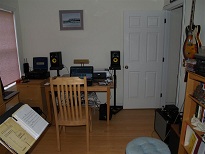
As I've been working on the two CDs that will go with our No Fret Cooking cookbook, I've upgraded the equipment at The Humble But Efficient Studio at Frogstory Records, with a new computer, KRK Rockit 5 studio monitors, and Sennheiser 280 Pro headphones. This has made tracking and mixing much easier. My goal is 22 songs on two CDS; "Music to Cook By" and "Music to Dine By". At this point, I have two more songs to compose. The others are in various stages of production, with 8 fully tracked, and many more partially tracked. I've been using TreePad to keep notes on the project. 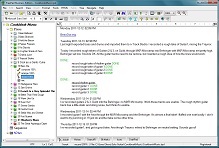
Here's a soundclip of a rough mix of one of the tunes: 12/13/2011 Chord Cord 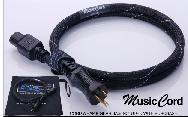
I have a new power cord, and thereby hangs a tale. Every year, on the first Saturday after Labor Day, Alex Case and his lovely wife Amy host a party at their home. They've built an extension on their house expressly for such occasions, a big room with a high slanting ceiling, and an S-shaped outer wall. I've had the good fortune to perform for this event for the past few years, sometimes solo, sometimes in a duo, once with a 7-piece band that I put together for the occasion. A few years ago I met Jim Anderson at this party. I had arrived early to set up, and to spend a few minutes chatting with Alex and Amy before the the mass of guests swooped in. As Alex helped me load in my equipment, he pointed out a couple of guests who had arrived early. "And that guy over there near the ice sculpture is Jim Anderson," he said. "Jim's a recording engineer. He's won nine Grammy awards." Later that night I had a chance to join a group of people who were chatting with Jim. One woman said, "So you've won nine Grammy awards?" Jim answered, "Well, I didn't do so good -- I was nominated for twenty-three, but I only won nine." I don't remember the exact numbers of awards and nominations brought up in that conversation, but it was a lot. At subsequent parties, I've had a chance to chat with Jim, and -- in spite of all his awards -- he's a very humble and down-to-earth guy. For this year's party, I arrived early as usual, and, as usual, Jim was there. Because the weather was warm, Alex asked if I'd set up outside, on the patio, near the end of the S-shaped wall. My duo partner, John Melisi, had not yet arrived, but I know John likes playing outdoors, so I made the executive decision and started setting up. Jim came over and chatted with me as I set up. When I plugged in and did a quick sound check, I found my guitar was picking up a lot of hum. Jim and I speculated about what might be causing it -- after all, I was outside and presumably away from dimmers and so forth. Just them Alex walked over. I mentioned that I was surprised there was so much hum. I knew from previous gigs there that in the new room Alex had installed studio quality dimmers, so I got no hum in the room. Alex said facetiously, "Gee, I can't understand it, you're plugged into the same outlet as the frozen drink machine and the popcorn machine. I can't imagine what might be causing the hum." He then went back to party preparations. I said to Jim, "I have a power conditioner in my trunk, maybe that will help." Jim said, "Can't hurt. " I grabbed my Monster power conditioner from the trunk. As I plugged it in and plugged the amp into it, Jim asked about it. We talked a bit about filters, surge suppressors, and such. Jim said, "You might want to try the products from ESP." He went on to tell that recently he'd been mixing Ron Carter's big band album. Some people in the control room were saying that the horns were sounding harsh. Jim had a couple of ESP power cables and plugged them into the monitors. After that, he said, no one complained about the horns. Later he tried the cables on his home stereo, and it "really opened up the sound." As we continued discussing the ins and out of electrical paraphernalia, I set up my folding music stand and put a couple of sheets of music on it. Jim asked, "Do you have clothespins to hold that music?" I said I didn't but we were only going to be reading two tunes. Jim said, "And the wind just might come up during those two tunes, and then what would you do. I'm going to get you some clothespins." I said, in disbelief, "You know where Alex and Amy keep their clothespins?" Jim said, "I've stayed here a few times," and went off in search of clothespins. I finished putting my cases away, and Jim returned with some clothespins. Now tell me: how many jazz guitarists get to have clothespins hand-delivered to them by a Grammy-award-winning engineer? The evening's music went really well. Jim, Alex and Amy, and many of the guests had very nice things to say about the music. The hum was not too noticeable, and those two sheets of music did not blow off the music stand. The next day I googled ESP (You can read Jim's comments on the ESP home page.) I decided to give the ESP MusicCord a try, and ordered one. It arrived a few days later. I plugged it into my Traynor amp and played some chords. Sure enough, they sounded fuller. To check, I swapped the ESP cord and the stock Traynor cord a couple of times. The first noticeable difference was in the fullness of the inner voices of chords, which gave the chords a fatter, richer sound. The bass notes were tighter, and the highs sweeter. Jim was right. He knows his electronics -- and his clothespins! The following weekend, as John and I were setting up for a restaurant jazz gig, I plugged the ESP cord into the Traynor. John was standing behind my amp, putting his tenor together. I strummed my favorite "big" chord, a BMaj/6/9/7. John gasped, and said, "Beautiful!" He had no idea I had a new cord, but he was flabbergasted by the sound. I played a few things and we discussed the sound of my guitar and amp with the new cord, and he agreed that sound was fuller and clearer. That was a few months ago, and I've been using the ESP cord ever since, on a variety of gigs and in my home studio, and I just love it. The greatest invention since clothespins! 09/28/2011 Playing For The Planet 
Yesterday Mal and I were having lunch in a small Mexican restaurant in Cambridge, MA. From our table I could browse the dozens of posters on the bulletin board. My eye fell on a picture of Eliot Fisk. The poster was about the upcoming "Playing For The Planet" concert, in which Fisk will be one of the performers. Just now I visited the event web site, and read the following: Mehmet Ali Sanlikol; Eliot Fisk & Zaira Meneses; Durga Krishnan. “Playing For The Planet” was conceived as a way for these creative musicians to contribute to the urgent struggle against global warming. Because the climate problem recognizes no national boundaries, the artists represent musical styles from three different parts of the globe. While the performers present different melodic and rhythmic concepts, they share key musical values: listening, honesty, creativity, and respect. And, of course, they are all committed to raising awareness of the potentially devastating effects of global warming. Key musical values: listening, honesty, creativity, and respect. That bears repeating. 09/25/2011 Noble Lustre 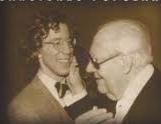
This morning I listened to a CD by Eliot Fisk -- and, of course, enjoying it -- and it made me wonder what he'd written about guitar education, so I browsed his site and found this letter he wrote to the editor of Soundboard magazine. A well-written and inspiring letter. I especially like Fisk's phrase, "noble lustre engendered by dedication and discipline." 08/20/2011 Project the Music Forward 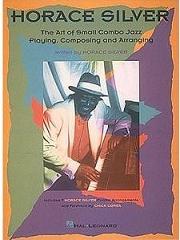
The physical energy needed for your instrument does not come from or project to the audience or your fellow musicians by turning up your amplifier. It comes from within your body and the way in which you attack your instrument. The determination that you project into your playing brings forth the physical energy or pulse needed to project the music forward in its strongest and most positive way. Horace Silver - The Art of Small Combo Jazz Playing, Composing, and Arranging, p. 23 08/12/2011 Online Music Degree 
I just learned of a web site, Online Music Degree, that has a list of the Top 40 Job Sites for Music Educators. The Top 40 list looks like a valuable resource. However, the main page of the site confuses me. It says "Find online music degrees and programs," but the dropdown filter includes just about everything except music. I selected Engineering, thinking that it might list places that offer music engineering courses. This returned a long list of links. I picked one at random, Arkansas. The page for that school listed only one music course, a lecture, and I could not find a music degree listed for the school. The site looks like it's new and under development, so maybe it will develop into a useful resource over time. At any rate, the Top 40 Job Sites list is worth a look, not just for music educators, but for working musicians, and musicians who want to work. 08/04/2011 Lunch Box Lite 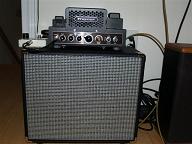
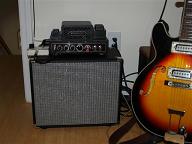
My 1x12 Lite cabinet arrived the other day from Mojotone. I took the Eminence speaker out of my Peavey and put it in the new cabinet. I had to go out to the hardware store and buy some longer screws because the lite cabinet was clearly not intended to be used with such a heavy speaker. But the install went smoothly. I fired it up and it sounds great. I've practiced through this rig for about 8 hours in these past two days, and I love the sound. Last weekend I used the Traynor by patching it into the Eminence speaker, bypassing the Peavey amp. This weekend I'll get to try this new rig. In my home studio, it sounds fantastic. I'm sure it will sound fantastic on the gig. I'll have a lot more to say in future journal entries about this little setup. 07/30/2011 New Lunch Box 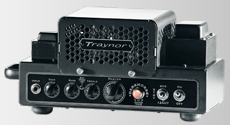
I'm not one to buy equipment often. I've been fortunate to find good equipment and use it for decades. So I wasn't in the market for a new amp, but I bought one because I fell in love with the sound. I was spending a few days in Brattleboro, VT with Mal. She was in class there all day, so I had time to wander around Brattleboro. When I visit a new town, I like to visit the library, the bookstore, and the music store. There are two music stores on Eliot Street in Brattleboro. One is on street level, and the other, Contemporary Music, is on the second floor. As I was walking around, I made a mental note of this. I figured that Contemporary Music was the underdog, getting less walk-in traffic, and since I always favor the underdog, I decided to check them out first. Back at the hotel, I checked out their web site. I liked the comments the owner had written about some of the guitars. He seemed knowledgeable and genuinely devoted to musical instruments. There was a Peavey thin hollow-body 335 style and an Epiphone fat hollow-body 175 style that looked interesting. The next day I dropped in to try them out, not because I was shopping, but just for the fun of it. As I browsed, I struck up a conversation with the owner, Ed. There was a vintage Fender Twin for sale, and Ed said he had restored it, which got us talking about tube amps, so, of course, I told him about my beloved Ampeg B-15. As I wandered over to look at the guitars, Ed gave me the rundown on a few and asked if I'd like to try any. I said I'd like to try the Peavey and the Epiphone. He set me up with a Traynor combo tube amp. I played the Peavey for a few minutes. I found it very hard to play, and impossible to play in tune, because the strings were so light, and the frets so high. After a few minutes Ed asked what I thought, and I gave him my comments. He understood. I tried the Epiphone with the Traynor combo. Ed asked what I thought and I said I thought the guitar had a good sound, but the amp did not seem to have an even frequency response, sounded a bit hollow in the low mids. "Why don't you try the Epiphone with this little tube amp?" Ed suggested, pointing to a little black lunch box. So I played the Epiphone through the Traynor Dark Horse head and cabinet. Ed explained the wide variety of settings on the amp. I played for quite a while, and when I was done Ed asked what I thought. I said, "Well, the guitars are nice, but not really what I like. But this little amp fascinates me." Ed told me more about the amp, even dug out the owners manual and showed me the specs. It was only listed at 15 watts, and I was a little concerned that it might not have enough power. Ed said there is a more powerful version, but he didn't have one in stock. I said I'd be curious to try the Dark Horse with my Aria. The next day I came back with my guitar. As I walked in, Ed said, "Hi, Steve. I see you brought your Aria." I was impressed that he remembered not only my name, but the make of my guitar. He wasn't just a slick salesman using this as a gimmick. He had heard me play and, as he told me later, he is "always glad to have a fine player in the shop." I plugged my Aria into my MXR Microamp, explaining to Ed why I use it (see Highs), and plugged into the Dark Horse. Ed left me alone to play as long as I wanted. I played every style of music I could think of -- jazz chord-melodies, improvised jazz lines, my funk originals, my New Age originals, some rock licks, walking bass, etc. -- and covered every fret on my guitar. The response of the amp was dazzlingly even from one end of the neck to the other, except for the lowest five notes. As a test I played my intro to "Skating in Central Park," which is a simple vamp of Cmaj7 G7, with the C bass note on the fifth string and the G bass note on the sixth string. The C was much louder and fuller than the G, and nothing I could do with finger pressure or pick attack, nothing I could do by tweaking the amp settings, could balance these notes. My guess was that the speaker Traynor supplies (I later learned it's a custom Celestion -- I dislike Celestions) has a sharp drop-off below about 90 Hz. Aside from that, the sound was perfect. The highs had that sweetness that I've never been able to get from my Peavey. Yes, I can get it from my Ampeg, but that is just too big and heavy for me to be carrying to two or three gigs a week at the age of 65. Here was a lunch-box-sized amp that has most of the good qualities of my beloved Ampeg. So, despite my concerns about power, and about those low notes, I made a leap of faith and bought the amp -- but not the cabinet. I wanted to try the Dark Horse with my Eminence Delta Pro 12A, which I know has excellent response down to about 80 Hz, the frequency of the lowest note on the guitar. When I got back home from Brattleboro I wired the Dark Horse head into the Eminence that is in my Peavey. The first thing I did was play that intro again. The bass notes were perfectly balanced. I played a few other things to test all the low notes and all were fine. I played various scales, arpeggios, chords, melodies, lines, and it all sounded great. My intuition was right: this head is the perfect match for the Eminence. I had a new lunch box. For the first time in 15 years I had a new amp. 07/13/2011 Nailing It 
On a recent gig, John Melisi watched my right hand as I played a chord-melody solo, and after the tune commented, "Your ring finger must get really calloused. You give it quite a workout! " I said it didn't, really, because the fingernail does a lot of the work. That gig was outdoors (in a tent with two open sides) on a rainy day, and my fingertips got spongy from all the moisture in the air, so the strings did not slide off off the fingertips smoothly. I was actually wishing I did have hard, smooth callouses, which would perhaps allow the strings to slide off smoothly. Fingernails are important to my sound. I use what's known as a "hybrid" approach: pick and fingers. My single-note lines are played almost exclusively with the pick, my chord-melody with pick-and-fingers. I use a heavy 2.0mm pick, and I want the sound of finger-picking to match the sound of the pick. Whether it's pick or fingers, the angle of attack affects the tone (see image above). In my finger-picking, I adapt the classical approach of letting the string slide off the fingertip, and then it hits the nail. The proportion of flesh to nail affects the tone, and this, in turn, is determined by the angle of the right hand. (Occassionally, for a really dark tone I'll use just the fingertip pad, or for a really bright tone, just the nail.) The shape of the fingernail is important, and with steel strings it's difficult to keep the nails at the right length and shape because the strings grind the nails down. I have to file them with a fine diamond file every day and polish them with emery paper before, and often during, each gig. When I first started playing chord-melody in hybrid style, I tried to play all the melody notes with my pinky. But I found myself playing a lot of them with my ring finger. At first I tried to "remedy" this, thinking it was just a flaw in my technique. But I think my inner player knew that the sound was always richer with the ring finger, because there's more flesh available to warm up the sound. 07/12/2011 Something to Say 
I got an interesting email the other day, which read, in part: Over the past couple of years I have visited your site numerous times, either to learn more about jazz theory and guitar technique or to enjoy your stories. I figure any jazz guitarist who has the courage to play an 40+ year-old Aria in public must have something worthwhile to say! Enough said! 06/23/2011 All Music All the Time 
I recently retired from software development, and I'm now spending all my time on music. Sure feels good! A recent history: From 1972 to 1997 I taught guitar at Berklee College of Music. In 1997, fed up with faculty politics, I resigned from Berklee. For the next 14 years I worked days as a software engineer, while continuing to do gigs and record. These days I teach a few lessons -- some at my home studio and some online. I continue to play several jazz gigs a week, in restaurants and bars. I'm composing a lot of music and recording it in my home studio. Now that I'm retired, I'm busier than ever -- and having a ball! 06/21/2011 No Substitute for Work 
There is, of course, no substitute for work. I myself practice constantly, as I have all my life. I have been told I play the cello with the ease of a bird flying. I do not know with how much effort a bird learns to fly, but I do know what effort has gone into my cello. What seems ease of performance comes from the greatest labor. Casals, Pablo. Joys and Sorrows 06/06/2011 Whole Self 

Oliver Sacks, writing about a patient with visual agnosia: But it was in her art, her music, that Lilian not only coped with disease but transcended it. This was clear when she played piano, an art that both demands and provides a sort of superintegration, a total integration of sense and muscle, of body and mind, of memory and fantasy, of intellect and emotion, of one's whole self, of being alive. Her musical powers, mercifully, remained untouched by her disease. Sacks, Oliver. The Mind's Eye pp. 29f. 05/24/2011 Two More Courses 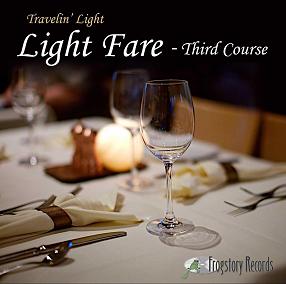
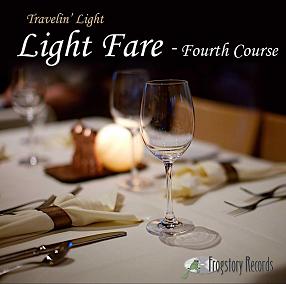
John Melisi and I recorded the CDs Third Course and Fourth Course two years ago at Alex Case's studio, but I just now got around to adding them to the Travelin' Light page. 05/18/2011 
The Music Index looks like a very useful new Internet resource. I learned about it in an email from the site's author, who had included my site in his listings. What I like about this new site is that it is uncluttered, featuring only a few carefully chosen music resources on the web. 04/14/2011 Bill Leavitt Guitar Octet In 1991, while I was teaching guitar at Berklee, I played in the Bill Leavitt Octet, with other faculty members. We put this ensemble together when Bill became ill, and we continued performing after Bill's death. This video was made after Bill's passing. The performance was in the Berklee Recital Hall known as 1A. Mark French, who plays rhythm guitar in this video, converted the old VHS tape to DVD, and I made this MP4 from that. So the video and audio quality is not good, but it's an interesting piece of history. I'll have more to say about this guitar ensemble in future Player's Journal entries, and I'll post more clips.
03/08/2011 Music Tools 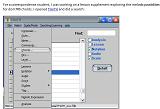
The other day I was working on a lesson for one of my correspondence students. I found myself using a wide variety of music tools, from the decades-old MusicPrinter Plus, to the latest version of Notion, and, of course, THoTH. I wrote a short article about some of the tools I used. As musicians, we have so many great tools available to us these days. As Maynard G. Krebs used to say, "What a wonderful age we live in!" 02/17/2011 Fra Diavolo Re-Seasoned 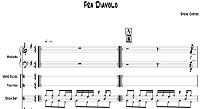
I did another mix of "Fra Diavolo." I decreased the reverb settings on the bass and drums in Notion, and re-exported those wav files, and then brought them back into the mix in n-Track Studio. I adjusted the levels just a bit, and added a fade out. It's getting tastier. 02/11/2011 Chilled 
I leave my Peavey amp in the trunk of my car all the time. I had some concerns about this, because the temperature overnight can reach 25 below zero here in New Hampshire. I googled this issue and read lots of opinions. The one that made most sense to me amounted to this: your car has transistors and electronics, it has stereo speakers, it sits out in the cold each night, and when you start it up in the morning and turn on the stereo, it works just fine. The Peavey is a solid state amp, so I don't think the cold bothers it. In fact, even my 40-year-old Ampeg tube amp spent many a cold night in the trunk. I was concerned that the tubes would crack. But as someone online observed, tubes heat up a lot slower than light bulbs, but the light bulbs in your car are fine after a night of low temperatures. I do find, however, that the speaker is a bit stiff after a cold night in the trunk. It takes about an hour of playing for the speaker to loosen up enough to produce good, warm, full bass notes, and sweet high notes. My theory is that the paper (or whatever it is) of the speaker cone becomes stiff from the cold and does not vibrate freely until it warms up. 02/11/2011 Playing Again 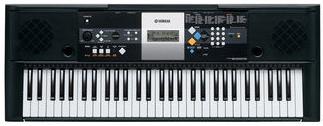
I bought Mal a surprise for her birthday: a Yamaha electric keyboard. She had taken piano lessons as a kid, but had the all-too-common negative experience. When we first got married, some 42 years ago, I bought her a keyboard. She took a few lessons with Paul Neves. We played together in a group we called Mousetrap! (The exclamation point was part of the name -- I thought that was so cool, at the time.) We played a few gigs at the Webster House on Newbury Street in Boston, in about 1968. What with raising two kids and all, she drifted away from playing keyboard. But lately she's been singing on a few gigs with me, and she's been wanting to get back to playing keyboard. She was quite surprised at the gift. We unpacked it and set it up and she immediately played a D major scale, an F major scale, even a B major scale. Considering that she only had a few lessons, and hasn't touched a keyboard in almost 40 years, that's amazing! She played a bunch of chords -- she got the 5th wrong on the B Major chord, but once I refreshed her memory on chord spelling, she figured that one out and started cranking chords out like a pro. She's already asking me to write her some keyboard parts that she can play on the CDs we'll be making to go with her cookbook. I can see that there's a whole new world ahead here! 01/31/2011 Fra Diavolo Simmering 
Mal is writing a cookbook, and I'm writing and recording music to accompany it. She has collected over 200 recipes, mostly her own, but others gathered from friends and family from across the country. Tonight she was cooking Scallops Fra Diavolo in the kitchen on the middle floor of our condo, and I was in my home studio on the third floor, composing, arranging, and recording my latest composition, "Fra Diavolo." I notated it in Notion, using marimba, flute, guitar, and percussion. I exported the tracks, and imported them into n-Track Studio, and overdubbed the two guitar tracks. Below is button that plays the rough mix. Still a lot of work to do, but I'm quite captivated by this piece. By the way, Mal's Fra Diavolo was quite tasty. I can only hope that mine will be as tasty! 01/13/2011 Not a Game 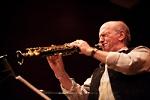
There's an excellent interview with Dave Liebman in this month's issue of JazzEd Magazine. He tells that when he was about 35, he wanted a little more meaning in his life, and that's how he got into doing clinics. Here's an excerpt from the interview: The teaching thing started to loom very high. I said, "The idea of spreading this music is important." Because I really believe in jazz and I love jazz. It's not just that I love playing jazz; I love what jazz represents; I love the tradition; I love everything about it. I think it's a great message to give to anybody, in particular young people, whatever they may do with it. It's just a great message. And I just started to think: this is a positive thing I can do. And I'm good at it; I'm a good verbalizer; I can do it well. So that was my way to find more meaning. And, number two, as a practical thing, to be honest with you, as a jazz musicain, you're not making a full living by going out and playing your horn every night. You've got to figure something out. Those days, teaching was not the common thing, but I didn't want to play in the studios, I didn't want to play any other kind of music. The missionary aspect of teaching, which any great teacher feels, took hold. The other thing is, I know when I leave an audience, whether it's a large or very small format, I know that they leave with an impression of what the music is about through my personality because a teacher, really, in this stuff -- I don't know about math or chemistry -- but when it's about an art form, the main thing that a student is getting is the personality of the guy who's speaking to them -- that and the information, of course. If the information is good and backs up the personality, this is a perfect world. If there's not much information, but a great personality, it's a nice way to spend an hour or two. If there's just information, but the teacher doesn't personify the music because maybe he or she isn't a performer, there's a gap. This music is about feeling. Feeling is the most important thing. Content, of course, is important, but what you're saying is what this music is about. That's what makes Dexter Gordon Dexter Gordon. It's his sound and his tonguing and all that, but it's about him as an individual and what he's saying. At a certain age, somewhere around 15, 16, it's very important for the kid to get the vibe of the joy of this music and of the intensity of the commitment. This is going to be work, this is long-term, the rewards are probably not going to be for 10 or 20 years and also this music has a deep tradition and you have to be true to it. This is not a game, this is not something you enter lightly. 01/02/2011 All Discipline 
Over the years I've continued to draw inspiration from Willie Ruff's memoirs, A Call to Assembly. Today I opened at random and read a passage where he tells about an eighteen-year-old trumpet player, Gilbert Upshur, who was in the Army band with Ruff. Our man was all discipline and dedication. He lived for his craft, was a flawless player, cool under public scrutiny, and quietly self-assured. I admired above all the way he went about his practice. I had never heard anyone get so much from a practice book. His daily musical calisthenics began early, and his was the first clarion to sound before breakfast each morning. While his barracks mates, still beneath the covers, fought to come awake, Upshur was up, washed, and already busy at his workouts. It was not unpleasant to lie abed a few extra moments in the dawn to listen to him begin his morning service to the trumpet. Ruff, WIllie. A Call to Assembly. p. 162 How does one manage to "get so much from a practice book"? Ruff doesn't elaborate on this, but I'm sure it has to do with discipline's necessary companion: concentration. And I'm sure that "our man" was concentrating on the same things I discuss in my article "What to Listen for in Your Practicing." I know all this, about what to listen for, about discipline and concentration, but even after nearly half a century of practicing, I'm still trying to develop discipline in my practicing. I'll try to keep "our man" Upshur in mind over the next few days each time I sit down to practice. |
